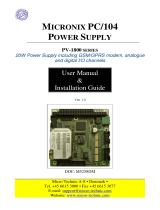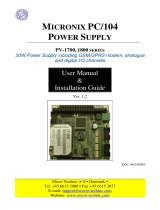Sierra Wireless GM48r5 is an advanced telematics module that combines multiple wireless technologies and interfaces with flexible I/O options to simplify integration into a diverse range of M2M applications. The GM48r5 has the advantages of Quad-band GSM/GPRS/EDGE connectivity, which enables reliable wireless connectivity. It is an ideal solution for applications that require flexible combinations of digital I/O, analogue inputs, UARTs, and other interfaces.
Sierra Wireless GM48r5 is an advanced telematics module that combines multiple wireless technologies and interfaces with flexible I/O options to simplify integration into a diverse range of M2M applications. The GM48r5 has the advantages of Quad-band GSM/GPRS/EDGE connectivity, which enables reliable wireless connectivity. It is an ideal solution for applications that require flexible combinations of digital I/O, analogue inputs, UARTs, and other interfaces.











-
 1
1
-
 2
2
-
 3
3
-
 4
4
-
 5
5
-
 6
6
-
 7
7
-
 8
8
-
 9
9
-
 10
10
-
 11
11
Sierra Wireless GM48 Application Note
- Type
- Application Note
Sierra Wireless GM48r5 is an advanced telematics module that combines multiple wireless technologies and interfaces with flexible I/O options to simplify integration into a diverse range of M2M applications. The GM48r5 has the advantages of Quad-band GSM/GPRS/EDGE connectivity, which enables reliable wireless connectivity. It is an ideal solution for applications that require flexible combinations of digital I/O, analogue inputs, UARTs, and other interfaces.
Ask a question and I''ll find the answer in the document
Finding information in a document is now easier with AI
Related papers
Other documents
-
Sony Ericsson GR47 User manual
-
Ericsson TT1222 MPEG-2 SD 4:2:0 User manual
-
Ericsson RBS 2206 User manual
-
 Micro Technic Micronix PV-1800 User manual
Micro Technic Micronix PV-1800 User manual
-
 Micro Technic PV-1700 User manual
Micro Technic PV-1700 User manual
-
 Ericsson Radio Systems AB B5KAKRC161028-1 User manual
Ericsson Radio Systems AB B5KAKRC161028-1 User manual
-
Ericsson SVP 2000 Reference guide
-
Wilden PCMI Engineering Operation & Maintenance Manual
-
Sony Ericsson K810 Electrical Repair Manual
-
Ericsson RX8320 User manual













